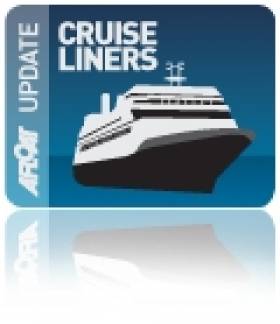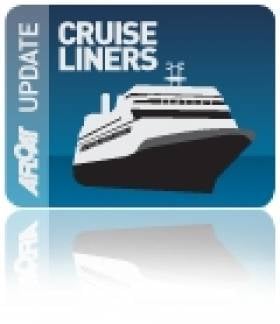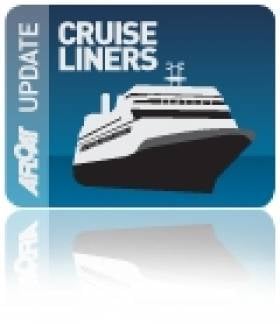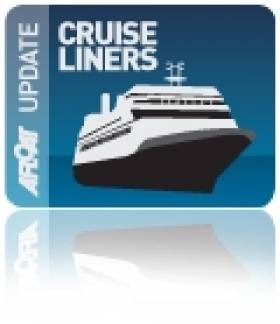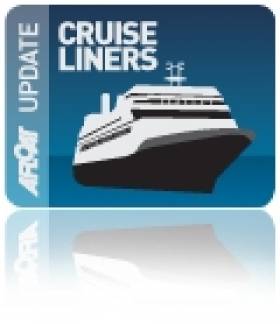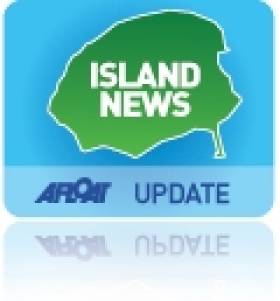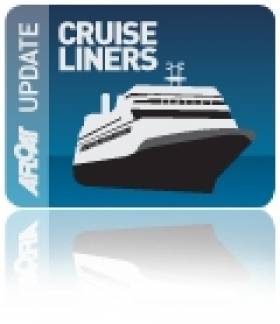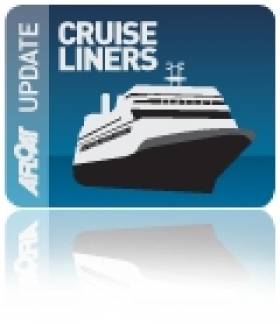Displaying items by tag: Cruise Liners
#P&O 175th ANNIVERSARY – The cruiseship Arcadia (2005/83,781grt) sailed into Dublin Port after an overnight passage from Southampton, where P&O celebrated their 175th anniversary on Tuesday with a spectacular parade of the fleet billed as the 'Grand Event', writes Jehan Ashmore.
Dublin Port is the first port of call since the 2,388 passenger (maximum) capacity Arcadia departed her homeport on a 14-night adult-only round trip cruise to Iceland. She and six cruiseships of the P&O Cruise fleet formed the impressive sail past down the Solent to where they each went their separate ways on cruising intineries.
The Peninsular and Oriental Steam Navigation Company, better known throughout the world as P&O was established in 1837. The famous company's colourful house-flag is flown on the P&O Cruises fleet and P&O Ferries operating out of the UK. The flag is also depicted as the funnel colours of the ferry fleet and incorporates the royal colours of Spain (red and gold) and Portugal (blue and white) which relate to the older traditional colours representing the monarchy.
In 2005 P&O was sold to Dubai based DP World for £3.3 billion, which operates P&O Ferries, while the cruise division was sold off to Carnival UK, a subsidiary of the US owned Carnival Corporation which among its many companies includes Cunard Line. The Arcadia and her fleetmates are under the P&O Cruise brand and the cruiseships also fly the house-flag under license.
The origins of P&O though can be traced as far back to 1815 when Brodie McGhie Wilcox engaged Arthur Anderson to become a ship clerk in his brokerage business in London. The Lime Street based brokerage initially chartered vessels and the business grew so by 1823 Anderson was made a partner to form Wilcox and Anderson. They embarked on a sail-cargo service from London to the Iberian Peninsula.
In 1835 the timber-built passenger and cargoship paddle steamer William Fawcett was chartered from the Dublin and London Steam Packet Company. The 206-tonne vessel gave a top speed of 10 knots, noting that she had two sailing masts fore and aft of the steamer's funnel.
William Fawcett is regarded to be the first ship in the P&O fleet, the steamer with the Irish connection carried the government contract to carry 'mails' to Iberia. The company secured more contracts and rapid expansion to the Orient, where the house-flag reached India, Ceylon, Penang, Singapore, Hong Kong and Australia. This led to many ships built and not just confined to cargoships, notably the liners with passengers travelling Port-Out and Starboard-Home...how POSH indeed!
It was fitting to see Arcadia arrive into a flat-calm Dublin Bay as she entered from the southern approaches off Dalkey Island, where paddle-steamers such as William Fawcett would of sailed past heading for London. Her modern short-sea successor in the form of P&O Ferries ro-pax European Endeavour (2000/ 22,125grt) was also arriving into the bay off the Baily lighthouse from Liverpool.
Arcadia cost £200m to build and when the vessel was laid down at the Fincantieri Cant. Nav. Italiani SpA shipyard in Monfalcone, she was originally the Queen Victoria for Cunard Line. It was however decided that the newbuild would be renamed Arcadia as she was transferred by Carnival to the P&O Cruises brand and given a traditional name.
To read more about the company, the ships and much more visit www.poheritage.com
#CRUISE LINER SAFETY – Following the Costa Concordia incident off the Italian coast in January, there are to be "tighter" inspections of cruiseships docking in Irish ports according to the State's Marine Survey Office.
Checks on safety and crew handling of "abandon ship" drills and fire-fighting will be stepped up under the office of the Department of Transport. Marine surveyors will also conduct "detailed, additional" checks on whether or not crews are trained and familiar with their vessels, the office says.
Some 30 passengers were confirmed dead and two are still "missing" after the Costa Concordia ran aground and partially sank off Isola del Giglio, Tuscany, on the night of January 13th last.
Cruiseship Call to Cobh on Irish Debut
#CRUISE LINERS – The newest addition to the Saga Cruises fleet Saga Sapphire (1981/37,301gt) is to make her debut to Dublin Port tomorrow, having made her inaugural Irish port of call to Cobh today, writes Jehan Ashmore.
Saga Sapphire previously the Bleu de France and launched as Europa for Hapag Lloyd, underwent a major refit taking several months in the Sicilian port of Palermo at the Fincantieri shipyard.
She arrived into her homeport of Southampton in preparation for her new owners 'maiden' cruise in late March which was delayed by several days. The delay in redelivering the 706-passenger cruiseship was due to strike action over redundancies at the shipyard.
Tomorrow she is due to berth in the capital port at Ocean Pier under the command of Captain Philip Rentell who has worked with the UK based operator when he joined the company in 2005 as master on their Saga Rose.
Bremen Visits Galway
#GALWAY CRUISE CALL– Following last month's first cruise call this season of Silver Explorer to Galway Docks, the city of the tribes welcomed the Bremen yesterday, writes Jehan Ashmore.
Unlike the Silver Explorer, operated by Silverseas Cruises, which transited through the narrow entrance into Dun Aengus Dock, the Bremen (1990/6,752grt) made an anchorage call offshore. The latter vessel which is operated by Hapag-Lloyd, has a four-star ranking according to the Berlitz Guide to Cruising 2012.
The small expedition ship takes her 164-guests who in comparison are served by a large crew numbering 100. The vessel visits some of the most beautiful and remote regions in the world which has included visiting both the poles at the Artic and Antarctica.
On this particular cruise, she had called to Kilronan, Inishmore on the Aran Islands and is currently underway heading for Tory Island.
The presence of the Silver Explorer, previously Prince Albert II, made for an interesting experience as Galwegians witnessed the vessel navigate skillfully through the tight confines of Dun Aengus dock system.
A further six cruise calls are scheduled, the next been Cruise & Maritime Voyages (CMV) Marco Polo, the classic cruiseship with her liner heritage is to make the port of call in July.
Former 'Lipstick' Ferry Calls to Saltees Islands
#SALTEES CRUISE CALL – The Saltee Islands off Co. Wexford was where the small cruiseship Expedition (1972/ 6,334grt) made an anchorage call yesterday, writes Jehan Ashmore.
The 140 passenger vessel which underwent a $13 million refit in 2009, specialises in cruising to some of the world's most remote regions. As usual for this type of cruiseship, a fleet of Zodiacs are provided for expedition excursions. Large common areas and observation decks provide panoramic views. As for all her cabins they too feature ocean-view windows or portholes and private en-suite facilities.
Expedition was a former Baltic Sea ferry which was sold in 2008 to G.A.P. Shipping Co. Ltd for their G-Adventures cruises having served as Ålandsfärjan for Viking Line's Mariehamn- Kapellskar on the Åland Islands route. The archipelago situated at the mouth of the Gulf of Bothnia form an autonomous Swedish-speaking region of Finland.
Prior to her Baltic Sea career she served P&O's subsidiary Normandy Ferries on the Dover-Boulogne route as their N.F Tiger which followed her original back-round as the Kattegat built for a Danish operator four decades ago.
The cruiseship retains her distinctive bright red hull colour inherited from her Viking Line years. Intriguingly when the company had to choose what colour to use for their first ferry Apollo, the answer found was rather novel as one of the owner's relatives produced her lipstick!
#HISTORIC LIVERPOOL CRUISECALL - Cruise & Maritime Voyages (CMV)'s Ocean Countess (1976/17,593grt) became the first turnaround cruise call in four decades after departing Liverpool on Tuesday, however the ship suffered temporary loss of engine power, forcing the vessel to turn around and divert to Holyhead, writes Jehan Ashmore.
The cruiseship with around 700 passengers had embarked during scenes of celebrations as crowds of onlookers gathered for the historic occasion at the Liverpool City Cruise Terminal. Several hours later into the first leg of an eight-night Scottish Isles cruise the incident took place while off the west coast of the Isle of Man.
With the detour to Holyhead, passengers disembarked at the Welsh port and where provided with a shore-side tour excursion programme. Incidentally the Anglesey port welcomed the vessel the previous day, as she made a scheduled call before completing the inbound turnaround at Liverpool.
CMV have scheduled a further ten turn-around cruises from Liverpool this year using the terminal that was completed in 2007 at a cost of £17m. Following Ocean Countess's inaugural turnaround, Princess Cruises considerably larger 3,000 passenger / 113,000 tonnes Caribbean Princess made a call yesterday.
The Liverpool City Cruise Terminal up until now could only accept transit calls as the facility was built with public expenditure. It was deemed otherwise unfair to compete with other leading UK ports with cruise infrastructure facilities that where not funded by the public purse.
In order for the Merseyside to accommodate turnarounds, this was made feasible as Liverpool Council agreed to repay close to €9m of a grant for the river-based terminal in addition build a baggage handling facilities.
Prior to the terminal opening, only small cruiseships could call but instead had to navigate within the dock system to Langton Dock.
Busy Day for Aran Islands Capital
#ARAN ISLANDS CRUISE CALL – Two vessels, a cruiseship and a lighthouse tender are today off Kilronan, the capital of Inishmore, the largest of the Aran Islands, writes Jehan Ashmore.
The ships are the 114 passenger cruiseship Island Sky (1992/4,200grt) operated by Noble Caledonia which called this morning having originally departed in Portsmouth and the Commissioners of Irish Lights tender ILV Granuaile (2000/2,365grt) which is based in her homeport of Dun Laoghaire.
Kilronan will be a hive of activity, not just those passengers tendered ashore from the cruiseship but also tourists arriving by frequent ferry services from Rossaveal, Co. Galway and Doolin in Co. Clare. The majority of sightseers will no doubt be heading for the main attraction of Dun Aengus fort on the far side of the island which is reached by shuttle buses and the traditional pony and trap.
The Island Sky's sister the Caledonian Sky which too is operated by the same company made yesterday an anchorage call off Sneem Co. Kerry. It is along the western seaboard that such smallships are attracting a niche market. In addition it is in these same waters is where ILV Granuaile is more often to be found working during the summer months as the weather is more favourable to carry out aids to navigation duties.
Unlike the cruiseship, the lighthouse tender does not actually anchor. Instead she can maintain a constant position using dynamic positioning (DP) which uses satellite technology to adjust the vessels manouvering systems to precise pin-point accuracy.
Small Cruiseship Set Sails for Sneem
#COASTING CRUISING – The small expedition cruiseship Clipper Odyssey (1989/5,218grt) departed Cobh Cruise Terminal this evening on a short cruise-hop along the West Cork coastline to Sneem in neighbouring Co. Kerry, writes Jehan Ashmore.
The twin funnelled vessel is normally associated with cruising in the Pacific on cruises from New Zealand to the Russian Far-East. For 2012, however she will be voyaging also to the Scottish Isles, Faroe Islands and Norway having previously served earlier this year on Indian Ocean safari cruises from Zanzibar to Mozambique visiting Madagascar and Mauritius.
A crew of 70 look after 128 guests accommodated in 64 cabins. Of the staterooms they all have ocean views, and each feature lower level beds, a private bathroom, sitting area with sofa, individual temperature control, in-room music systems and television.
At the stern is the fitness suite and outdoor pool. Other facilities include a lounge, library, gym, a medical clinic staffed by a registered physician and a gift shop. The small vessel is ideally suited for calling to shallower waters, where passenger can reach shore destinations using the vessels own tender fleet made up of Zodiac craft.
The Bahamas flagged vessel was last refurbished this time last year and she is operated by Noble Caledonia which specialise in providing a diverse range of cruising opportunities including those sailing under sail.
The company's Caledonia Sky (1991/4,200grt) has also been cruising in Irish waters this week. The 114 passenger vessel is better known as the Hebridean Spirit which had for many years operated for Hebridean Island Cruises. While on a cruise around a decade ago she made a rare promotional port of call to Dun Laoghaire Harbour.
Historic First as Cruiseship Calls to Drogheda Port
#DROGHEDA CRUISE CALL – The first ever cruiseship to visit Drogheda Port was welcomed this morning as Noble Caledonia' 122 passenger Clipper Adventurer (1975/ 4,367grt) entered the mouth of the Boyne, writes Jehan Ashmore.
Onlookers came out to view the historic arrival of the 101m long vessel which normally cruises in polar waters, either Antarctica or the Arctic. She berthed at Tom Roe Terminal, downriver from the older town-centre quays, having set off from Cork earlier this month on a 10-day circumnavigation cruise of Ireland.
On board the ice-strengthened exhibition vessel were American and Canadian passengers who were on the cruise organised by Adventure Canada, in association with Royal Canadian Geographical Society. Prices for the cruise which featured a varied lecture programme started from $3,995 dollars.
Facilities include a main lounge, bar, clipper club, library/card room, gymnasium and gift shop and throughout the intimate vessel, she sports plenty of varnished wood, brass, and timber lined decks. The new outside cabins have lower beds and private facilities in addition each with window view.
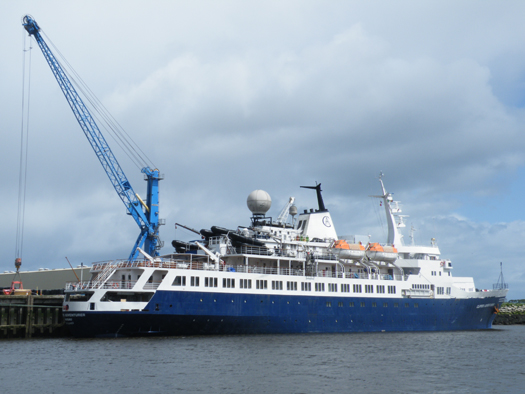
M.V. Clipper Adventurer moored alongside Tom Roes Terminal, Drogheda Port.
Photo: Jehan Ashmore
It is estimated the passenger spend generated from the cruise to the Boyne Valley is €60,000, the windfall will be a boost to the local economy. On foot of this the Drogheda Port Company has been in dialogue with a number of interested parties to build the brand and grow cruise business tourism in the region.
A small cruiseship such as Clipper Adventurer offers a more 'boutique' style of operation, in that she calls to more isolated destinations compared to the really large cruiseships. Among the ports of call on this Irish cruise they were to Kinsale, Dingle, Cliffs of Moher, Aran Islands, Westport and Tory Island.
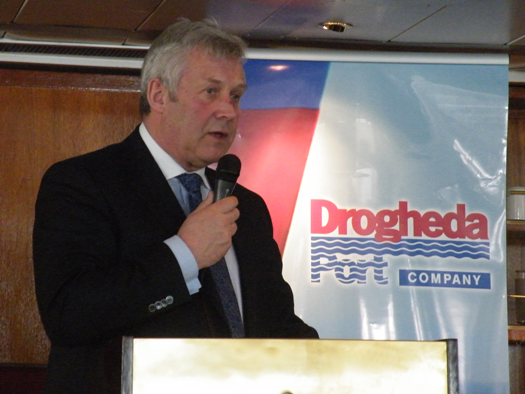
Minister of State Fergus O'Dowd speaking at a reception on board Clipper Adventurer to mark the historic cruise call visit
Where there are no port berthing facilities, passengers use instead a fleet of the vessels zodiacs which whisk them ashore to make excursions. Today her passengers disembarked to take a coach tour to the world famous visitor attractions along the Boyne Valley, before flying out of Dublin airport.
Not only is the cruise call a first for Drogheda Port but where a fly-cruise option is made available and also in reverse as the crew of the Clipper Adventurer are to welcome this evening more passengers flying in from Denmark. These passengers are to embark on a 6-day cruise of the Scottish Isles, terminating at Lerwick. The cruise is organised by Copenhagen based Albratros Tours.
Cruiseship's Return Consolidates New Business
#CRUISE CALLER – The small expedition cruiseship Quest made a return port of call to Dun Laoghaire Harbour early this morning, having inaugurated the season last month, writes Jehan Ashmore.
The 50m long vessel operated by Noble Caledonia carries 52 passengers and a crew of 25 had sailed overnight from Holyhead. She departed the Anglesey port at 20.00hrs and she took a leisurely 10-hour passage to cross the 60 nautical mile Irish Sea route.
Her visit to Dun Laoghaire today will provide her passengers to visit Powerscourt and Mount Usher Gardens in Co. Wicklow as part of a Garden themed cruise throughout destinations in the UK and Ireland.
On this occasion she is taking the cruise in reverse direction having previously made a southbound circuit starting at Oban and ending in Poole.
Likewise to her call nearly three weeks ago, she is moored alongside Carlisle Pier, which is designated berth number two out of a total five berths that are used for commercial vessels.



























